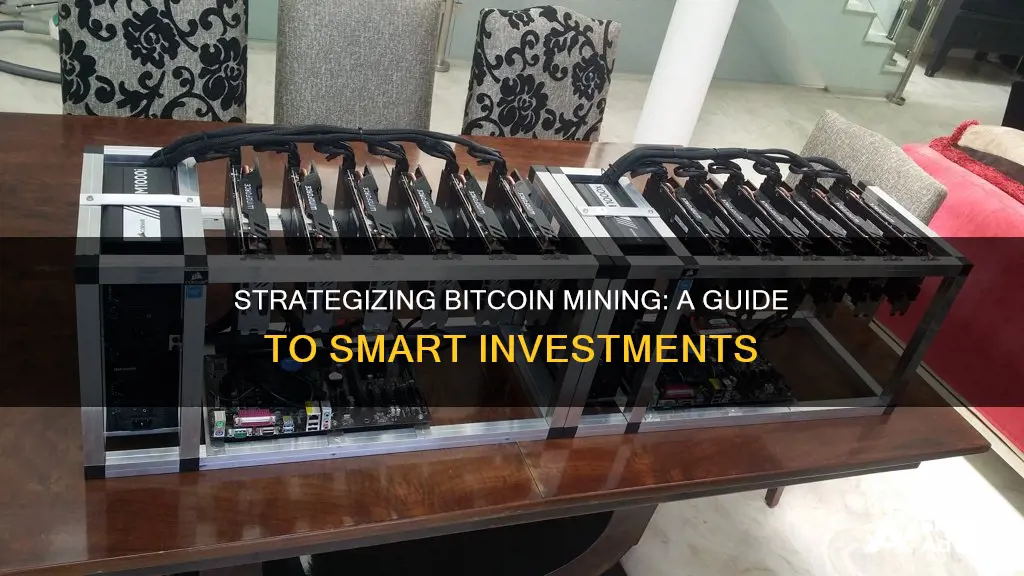
Bitcoin mining is a process that creates new Bitcoins and releases them into circulation. It involves solving complex mathematical equations to validate transactions and secure the network. Miners are rewarded with Bitcoin for their efforts. The process requires substantial hardware and electricity costs, and the competition for rewards has led to an arms race for faster, more powerful mining equipment. While Bitcoin mining has attracted criticism due to its energy consumption, it remains a popular way to invest in Bitcoin. This paragraph provides an introduction to the topic of 'how to invest in bitcoin mining', covering the basic process, costs, challenges, and potential rewards.
| Characteristics | Values |
|---|---|
| Process | Creating new Bitcoins and releasing them into circulation |
| Purpose | Validating transactions and creating new coins |
| Rewards | 3.125 BTC per block, shrinking by half roughly every four years |
| Energy Sources | Hydroelectricity, renewable energy, coal, electricity |
| Risks | Financial, safety, environmental, and regulatory |
| Types | ASIC, GPU, CPU, cloud, and pool mining |
| Companies | Riot Platforms Inc., Marathon Digital Holdings Inc., Cipher Mining Inc., Hut 8 Mining Corp., TeraWulf Inc., Bitfarms Ltd. |
What You'll Learn

Bitcoin mining hardware
Firstly, it is important to understand the three key factors that determine a crypto miner's profitability: hardware costs, energy prices, and the price of cryptocurrency. Hardware machines called ASICs (Application-Specific Integrated Circuits) can cost as much as $10,000 for the highest possible hash rate. These machines also require substantial maintenance and temperature-controlled facilities to keep them running optimally.
When choosing a Bitcoin mining machine, it is essential to consider the hash rate, power consumption, cooling system, and noise level. The Bitmain Antminer S21 Hyd 335T is currently the most profitable Bitcoin mining machine, with a hash rate of 335Th/s and a hydrocooling feature. It is also relatively inexpensive at $4,200+. Other profitable options include the Canaan Avalon Made A1366, which has a hash rate of 130 terahashes per second and the MicroBT Whatsminer M50S, which has a lower hash rate of 126 terahashes per second but is far cheaper, starting at $2,999.
For those looking to mine other cryptocurrencies, the Bitmain Antminer KS3, Bitmain Antminer D9, and Bitmain Antminer K7 are solid choices. It is worth noting that Bitcoin mining machines remain expensive, and it is crucial to research energy costs before investing.
Additionally, some investors opt for mining pools, where groups of miners combine their hash rates digitally to increase profits. This option may be more cost-effective, but investors must still purchase and maintain efficient hardware.
In conclusion, investing in Bitcoin mining hardware requires careful consideration of various factors, and it is a significant financial commitment.
Coinbase Pro: A Safe Bet for Crypto Investors?
You may want to see also

Bitcoin mining pools
There are several benefits to joining a mining pool. Firstly, it is the most affordable way to increase the odds of receiving a cryptocurrency reward. Mining pools give everyone a fighting chance against those who have built vast, ultra-expensive mining farms. Additionally, mining pools require less of each participant in terms of hardware and electricity costs, increasing the chances of profiting.
However, there are also some disadvantages to joining a mining pool. By taking part in a mining pool, individuals give up some of their autonomy in the mining process as they are typically bound by terms set by the pool itself. They are also required to divide any potential rewards, resulting in a lower share of earnings for each individual.
Some of the dominant mining pools in the Bitcoin mining process include AntPool, Foundry, ViaBTC, F2Pool, and Binance Pool. These groups consolidate much of the Bitcoin blockchain, which goes against the intended decentralised structure of Bitcoin and other cryptocurrencies. Despite this, it has become necessary for users to participate in pools if they want to receive rewards and help the blockchain function.
When choosing a mining pool, it is important to consider the payout scheme and the transparency of the pool's operations. In general, the bigger and faster the pool is, the more likely you are to receive rewards. However, there may be a point where pools become too large to be beneficial for individual miners.
Smartly Diversifying Your Crypto Portfolio: How Many Coins?
You may want to see also

Bitcoin mining profitability
Bitcoin mining can be a profitable endeavour, but it requires significant capital investment in processing power and electricity to complete the complex calculations needed to verify data blocks on the blockchain. The profitability of Bitcoin mining depends on several factors, including hardware costs, energy prices, and the price of Bitcoin.
Hardware Costs
Miners need to invest in high-end semiconductors, which can be expensive due to the global semiconductor shortage. Additionally, miners need to purchase or lease specialised mining hardware, such as ASICs (Application-Specific Integrated Circuits), which can cost up to $10,000 each. These machines also require substantial maintenance, including temperature-controlled facilities, to ensure optimal performance.
Energy Prices
Bitcoin mining consumes a lot of energy due to the high processing power required. Miners are incentivised to find the cheapest sources of energy available, and renewable energy sources, such as hydroelectric power, are becoming increasingly popular. China, for example, has a large number of crypto miners due to the low energy prices during the rainy season when hydroelectric dams produce excess energy.
Price of Bitcoin
The price of Bitcoin also affects mining profitability. When Bitcoin prices rise, the value of the Bitcoin rewarded to miners also increases, making mining a more attractive proposition. However, the price of Bitcoin can be volatile, and miners are exposed to the risk of price fluctuations.
Alternative Mining Methods
There are alternative mining methods that can reduce costs and improve profitability. For example, cloud-based mining involves leasing mining contracts from hardware facilities, allowing miners to earn rewards remotely without investing in expensive hardware. Mining pools are another option, where groups of miners combine their hash rates digitally to increase profits and spread the cost of hardware and maintenance.
Investing in Mining Companies
Instead of mining Bitcoin directly, investors can also consider investing in mining companies or purchasing mining equity. This allows investors to participate in the Bitcoin mining industry without the high upfront costs and technical complexities of direct mining.
Mark Cuban's Crypto Portfolio: His Top Investments
You may want to see also

Bitcoin mining safety
Bitcoin mining is a legitimate way to earn cryptocurrency and support the blockchain network, but it is not without its risks. Here are some key considerations and safety measures to keep in mind when investing in bitcoin mining:
Understanding the Process
Before investing in bitcoin mining, it's important to understand the process and the underlying technology. Bitcoin mining involves solving complex mathematical equations using specialised computers or hardware. This process is designed to be resource-intensive and challenging, requiring significant computational power and energy. The miner who solves the equation is rewarded with new bitcoins.
Financial Considerations
Bitcoin mining requires a substantial financial investment in high-end hardware and processing power. The profitability of mining operations depends on several factors, including hardware costs, energy prices, and the market price of bitcoin. It's important to carefully consider these expenses and the potential returns before investing.
Cyber Security Threats
As bitcoin and other cryptocurrencies gain mainstream traction, they also attract cybercriminal threats. Cryptocurrency-mining malware is a significant concern, where malicious actors infect systems and devices, turning them into cryptocurrency-mining machines. These types of malware can impair system performance, increase wear and tear, and expose users to information theft and hijacking. It's crucial to prioritise cybersecurity measures, such as regularly updating devices, changing default credentials, and enabling firewalls.
Environmental Impact
Bitcoin mining has come under scrutiny for its environmental impact due to the significant energy consumption required for mining operations. To mitigate this, some miners are turning to renewable energy sources, such as hydroelectric power. By using renewable energy, miners can reduce their environmental footprint and take advantage of lower energy costs.
Pool Mining
Individual bitcoin mining can be costly and less efficient compared to pool mining. Pool mining allows miners to combine their hash rates digitally, increasing the chances of solving equations and improving profitability. However, it's important to carefully vet and select reputable and secure mining pools to minimise the risk of potential scams or security breaches.
Regulatory and Legal Considerations
The legal status and regulatory landscape of bitcoin mining vary across different countries and jurisdictions. It's important to stay informed about the legal and tax implications of bitcoin mining in your region. Additionally, be cautious when choosing partners or platforms for mining, as scams and fraudulent activities have been reported in the bitcoin mining space.
Bit Coin: Safe Investment or Risky Gamble?
You may want to see also

Bitcoin mining stocks
One way to invest in Bitcoin mining is through mining equity, or mining stocks. This form of investment is similar to owning stock in a company that produces a product. For example, companies that own and maintain a substantial amount of Bitcoin mining machines can offer investors indirect participation through the sale of equity positions in their respective firms.
Another way to invest in Bitcoin mining is through standardised hashrate tokens. This token model allows investors to participate in mining activities as though they are miners, but without the complexity and upkeep of owning hardware. Tokens also ensure investors a guaranteed amount of hashrate power every day and their fair share of mined Bitcoin.
Some Bitcoin mining stocks include Riot Platforms, Marathon Digital Holdings, CleanSpark, Core Scientific, Cipher Mining, Hut 8, and Bitfarms.
It is important to note that the Bitcoin halving, which occurs roughly every four years, can impact the profitability of Bitcoin mining stocks. The halving reduces the rewards paid out to miners for adding new blocks to the Bitcoin blockchain, which can lead to reduced revenue and profit for mining companies.
The Ultimate Guide to Investing in Bitcoin
You may want to see also
Frequently asked questions
Bitcoin mining is the process of adding another block of data to a blockchain. To do so, a highly specialised computer solves a complex mathematical equation. The miner who solves the equation is rewarded with new bitcoin.
You can start Bitcoin mining by buying an ASIC miner, choosing a location to set it up, setting up a crypto wallet, and joining a mining pool.
The biggest risk of Bitcoin mining is that you won't make back your startup costs. It's also possible to damage your home's electrical system or overload the power grid.
Alternatives to buying an ASIC miner include GPU mining, CPU mining, cloud mining, and joining a mining pool.







